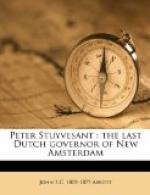At Flushing a cobbler from Rhode Island, a baptist, William Wickendam by name, ventured to preach, “and even went with the people into the river and dipped them.” He was fined one thousand pounds and ordered to be banished. As he was a poor man the debt was remitted, but he was obliged to leave the province.
It will be remembered that thus far nearly all the operations of the Dutch, in the New World, had been performed under the authority of Dutch merchants, called “The West India Company.” Their chartered powers were very great. Only in a subordinate degree were they subject to the control of the States-General.
At this time there was a very cruel persecution commenced by the Duke of Savoy against the Waldenses. Hundreds of them fled to the city of Amsterdam, in Holland, which was then the refuge for the persecuted of all nations. They were received with the most noble hospitality. The city government not only gave them an asylum, but voted large sums from its treasury, for their support.
Carrying out this policy, the city decided to establish a colony of its own in New Netherland, to be composed mainly of these Waldenses. The municipal authorities purchased of the West India Company, for seven hundred guilders, all the land on the west side of South river, from Christina kill to Bombay Hook. This gave a river front of about forty miles, running back indefinitely into the interior. This region was named New Amstel. The colonists were offered a free passage, ample farms on the river, and provisions and clothing for one year. The city also agreed to send out “a proper person for a schoolmaster, who shall also read the holy Scriptures in public and set the Psalms.” A church was to be organized so soon as there were two hundred inhabitants in the colony.
[Illustration]
The Company wrote to Stuyvesant saying,
“The confidence we feel about the success and increase of this new colony of which we hope to see some prominent features next spring, when to all appearance, large numbers of the exiled Waldenses will flock thither, as to an asylum, induces us to send you orders to endeavor to purchase of the Indians, before it can be accomplished by any other nation, all that tract of land situated between the South river and the Hook of the North river, to provide establishments for these emigrants.”
On Christmas day of 1656, three vessels containing one hundred and sixty emigrants, sailed from the Texel. A wintry storm soon separated them. The principal ship, the Prince Maurice, which had the largest number of passengers, after a long voyage, was wrecked on the South coast of Long island, near Fire island inlet, in the neighborhood of the present town of Islip. It was midnight when the ship struck. As soon as it was light the passengers and crew succeeded in reaching the shore in their boats through the breakers and through vast masses of floating ice.




